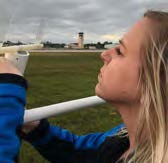These STEM Women Are Buzz Kills by Patrick Linn, MS, MSHAPI

Patrick Linn, MS, MSHAPI Executive Director, Collier Mosquito Control District
The latest U.S. Census reports that only 27% of workers in STEM (science, technology, engineering, math) careers are women, but at Collier Mosquito Control District (CMCD), 100% of the agency’s science department is staffed by women, including two with advanced degrees.
For our area’s mosquitoes, they present a real buzz kill. From identifying mosquito species new to our area to conducting industry-leading research, these women are making a difference locally and globally. In 2021 alone, a few of their accomplishments included:
• Detecting four mosquito species not seen previously in Collier County, including the Aedes scapularis, which is capable of transmitting yellow fever, lymphatic filariasis and Venezuelan Equine Encephalitis. These mosquitoes were found in traps placed throughout the District.
• Testing trapped mosquitoes’ RNA in CMCD’s PCR machine (a routine weekly activity) revealed West Nile virus in the area’s mosquitoes in June, which prompted notification to the Collier Health Department and media alerts to inform the public to take precautions.
• By invitation only, the research team conducted ground testing of a vendor’s new mosquito control material that could potentially revolutionize the industry.

Rachel Bales Biologist BA in Marine Science
Rachel Bales Biologist • BA in Marine Science, Florida Gulf Coast University • 5 years at CMCD “I love the versatility of my duties at CMCD. Every day – be it in the field, lab, the sky, or outreach events – I feel fortunate that I can utilize what I have studied to make a meaningful impact in our community.”
Keira J. Lucas, Ph.D. Deputy Executive Director • 4.5 years at CMCD Ph.D. in Genetics, Genomics and Bioinformatics from the University of California, Riverside. “My focus in vector biology and mosquito-borne disease led me to mosquito control. My research interests have blossomed into understanding the ecology and physiology of each targeted mosquito species and tailoring management plans to their specific vulnerabilities. Using applied sciences and working with a diverse group of professionals at CMCD to develop a science-based approach to mosquito control and make a difference in our community has been especially rewarding.” FEATURED PHOTO

Rebecca Heinig, Ph.D.
Director of Research
Rebecca Heinig, Ph.D. Director of Research • Ph.D. in Entomology from The Pennsylvania State University 3 years at CMCD “I’m a medical entomologist at heart, so CMCD has been a uniquely rewarding place to work. On the entomological side, I’ve already identified six new species that hadn’t been recorded in the county before, bringing our total number of known species to 50. On the human health side, we monitor a number of endemic arboviruses such as West Nile virus, but we also have some novel arboviruses whose significance isn’t clear yet, giving our work a real sense of urgency and purpose. When you add in a supportive community and leadership that prioritizes strong science as a foundation for integrated mosquito management, there’s nowhere else I’d rather be.”
List of publications/research posters
• New county records for mosquito species in southwest Florida (in progress). Heinig RL et al.
• Operational analysis of Collier Mosquito Control District’s BGCounter program (in progress). Heinig RL et al.
• KDR genotyping in Collier County FL Aedes aegypti populations. Bales RB, Lucas KJ
• Biologist Analysis of the Voltage-gated Sodium Channel (VGSC) target site mutation, L1014F, and pyrethroid resistance in Culex
quinquefasciatus field populations from Collier County, FL. Lucas KJ*, Bales RB, McCoy K, Weldon C.
• Evaluation of emergence trap design for the collection of Mansonia mosquitoes associated with Pistia stratiotes. J Am Mosq Control
Assoc. Bales RB, Brake P, Minio M, Weiss A, Lucas KJ*. (in preparation)
• Ornamental bromeliads of local Botanical Gardens serve as larval production sites for pyrethroid-resistant Culex quinquefasciatus
in Collier County, Florida. J Florida Mosq Control Assoc. 68: 14-23. Watkins A, Babcock E, Lucas KJ*. (2021)
• The impact of Hurricane Irma on our community and the Collier Mosquito Control District’s mission. J Am Mosq Control Assoc. 36(2s): 11-14. King RA, Heinig R, Linn P, Lucas KJ*. (2020)
• Oxidase, esterase and kdr-associated pyrethroid resistance identified in Culex quinquefasciatus field collections from Collier
County, Florida. J Am Mosq Control Assoc. 36(1):22–32. Lucas KJ*, Bales RB, McCoy KD, Weldon C. (2020)
• The impact of Hurricane Irma on population density of the Black Salt Marsh Mosquito, Aedes taeniorhynchus (Wiedemann), in Collier
County, Florida. J Am Mosq Control Assoc. 35(1):71–74. Lucas KJ*, Watkins A, Phillips N, Appazatto DJ, Linn P. (2019)
Want to know more about the science behind mosquito control? Looking for someone to speak to your group’s next meeting? Visit the District’s website at cmcd.org or call 239.436.1000





Leave a Reply
Want to join the discussion?Feel free to contribute!